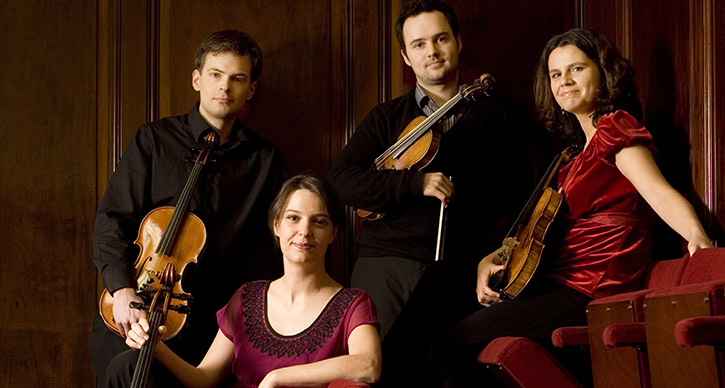The Audio-Biography Of The String Quartet

Photo: Elias String Quartet. Photo by Benjamin Ealovega.
The program the Elias String Quartet will share in its UMS debut on March 18 is like a sonic timeline of Classical Music’s most important genres, the string quartet. The three works the group will perform – Beethoven’s String Quartet in E minor, op. 59, no. 2., Debussy’s String Quartet, and György Kurtág’s Officium Breve – fit together like a veritable textbook on how the string quartet was established, codified, and subsequently transformed from the nineteenth century through the 1980s. It is extremely unusual, and very exciting, to have so succinct and comprehensive a portrayal of music history available on a single concert program.
Of course, this history begins with Beethoven, whose “middle” period works, such as the op. 59 quartets, represent his great turning point from an extremely skilled and gifted Classical composer, to the daring and freely minded Romantic hero music lovers glorify today. Beethoven’s metamorphosis was extremely precipitous to the history of Classical Music in the nineteenth century, and the String Quartet in E Minor, op. 59, no. 2 is certainly part of this legacy. This specific work contains numerous instances of Beethoven’s personality infecting the music’s form and affect; for example, in a likely allusion to the impolite Russian count who commissioned the set this quartet is part of, the work’s scherzo movement features an indelicately harmonized melody that was popular in Russia.
In light of the nearly invincible grip Beethoven’s influence had on nineteenth century composers, it is reasonable to think Debussy considered the German’s quartets when he penned his own in 1893. With that said, Debussy’s String Quartet, like his other music, breaks Beethoven’s mold in a number of ways, most obviously in its exploitation of instrumental color (listen for the prominent pizzicato passages in the second movement!). However, we should not interpret Debussy’s innovations as dismissive – rather, he makes vital changes to a genre that was over a century old at the time, and the musical expressions he explores are echoed by other composers in the early twentieth century, such as Maurice Ravel and Leoš Janáček, among others.
If Debussy’s String Quartet upholds through modification the traditional character of the string quartet as a stand-alone art form, a work like Kurtág’s Officium Breve shows how composers at the end of the twentieth century sought to more totally liberate this ensemble from its longstanding heritage. Officium Breve is starkly different from the other two works on the program – it is made up of fifteen short movements and is populated by constantly-shifting sounds and textures that represent extremely terse expressions on the part of the composer. Ranging from violent explosions of sound to tender periods of quietude, this work is enormously vibrant and deeply captivating.
Despite the fact Officium Breve bears little salient resemblance to the heart of its genre’s tradition, Kurtág’s work echoes the philosophy conveyed in the quartets of Beethoven and Debussy: existing forms may, and should, be altered in the name of artistic expression and ego. Placing living composers in a linear context with widely performed and recognized historical composers helps us, as listeners, observe how recently written music relates to the traditions with which we are more familiar. Unlike ensembles that predominantly program music from the nineteenth or eighteenth centuries, the Elias String Quartet is inviting its audience to share in these connections and is giving us a chance to see how a hugely important genre in Classical Music has grown over its centuries-long life.
Interested in more? Read more Garrett Schumann’s writing on UMS Lobby.






